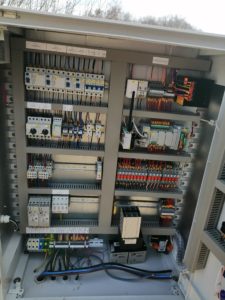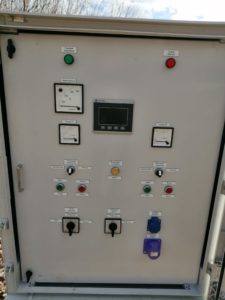Project description
The smart monitoring and management system for the water and sewage systems is not only an opportunity to significantly reduce lost retention, but also a great convenience, safety and lower operating costs. One of such solutions is Bumerang SMART, used for controlling the operation of nine pumping stations in Rybnik, installed as part of the construction of a new road.
Objectives of the project in Rybnik
The purpose of the project was to build a regional Racibórz-Pszczyna road and a downtown road on the section between the downtown junction to the intersection with Obwiednia Południowa Street in Rybnik. The entire project was financed by the EU from the European Regional Development Fund under RPO WSL 2014–2020, own funds, funds of the European Investment Bank, and a special-purpose subsidy from Żory.
The undertaking involved the construction of a new surface of two two-lane roadways with verge and a hard shoulder, and the construction of road junctions and intersections, overpasses and bridges. The existing roads also undergone a major reconstruction.
Water-related challenges during the project in Rybnik
We should note, however, that the Rybnik area is located in the basin of the Oder River. The Ruda River flows from the south-east to the north-west and shapes mainly the layout of surface waters and the first aquifer in the city. The left-bank tributaries of the Oder, such as the Gzel, Nacyna, Boguszowicki and Kłokociński brooks, receive waters in the southern part of Rybnik.
Hence, during the works it was necessary to drain a considerable amount of rainwater from the newly formed sealed areas, and therefore to build as many as nine rainwater pumping stations. Ecol-Unicon’s BUMERANG SMART control system was used to support their day-to-day operation.
Using the HYDROZONE BENEFIT retention reservoir
All the works consisted of five stages:
- I – road section in the town of Żory – from the built roundabout to the border of Żory and Rybnik
- II – road section from the border of Żory to the Gotartowice junction
- III – section from the Gotartowice junction to the Chwałowice junction
- IV – road from the Chwałowice junction to the Wodzisławski junction
- V – section from the Wodzisławski junction to the intersection with Sportowa Street with the intersection.
Separate design documentation was prepared and the necessary decisions were obtained for each stage for the purposes of the project.
The works involved the construction of a rainwater drainage network, in particular:
- construction of a system of drainage ditches along with installation of pre-treatment devices,
- construction of catch basins and elements supplying water to pre-treatment devices and the receiver,
- construction of street gullies, reinforced concrete manholes, one-sided inlets in ditches, elements of slope outlets, house drain outlets and concrete outlets on the banks of watercourses, ditches and rivers.
Technical aspects of the project in Rybnik
Before bringing rainwater into natural watercourses, pre-treatment devices were installed, including sedimentation tanks and oil/water separators.
The construction of prefabricated concrete outlets to ditches or watercourses was planned on sections of the rainwater drainage system, and the Kłokocinka River receives water from the rainwater drainage system. Rainwater from the surface of roads and pavements is now collected by rain inlets with settling tanks that stop sand, leaves and other fractions of suspended matter. Rainwater and snowmelt is then discharged from road gullies to road ditches through house drains with an outlet on the slope of the ditch with paving or through the use of slope sewage.
Coarser fractions and larger solid pollutants in rainwater flowing by roadside ditches are stopped before the inlet to the catch basin in the settlement section at the very ditch and on the basin grate, and then in the settlement section of the catch basin.
The designed sewage system was laid in the ground along its entire length. The pipes were placed in a trench with removed debris, concrete and stones, while sandy soil or sand was used to backfill the trench.
Highway sedimentation tanks with a float closure at the outflow were used to protect the natural environment against the flow of pollutants, to reduce the total suspended solids in rainwater discharged to the reservoir. To reduce the concentration of pollutants, lamella separators were designed to work with sedimentation tanks.
Integration of Bumerang SMART with the project in Rybnik
Measuring devices and remotely controlled actuators were placed on the installed pumping systems, while the collected data are transmitted via the GSM network to the monitoring system. This makes it possible to monitor the operation of devices on an ongoing basis and to quickly respond and start the necessary processes in the case of undesirable events.
Data from Bumerang SMART monitoring not only provide great support for the ongoing control, but may also be used in long-term development plans for operating activities.
Bumerang SMART and pumping station control
Smart monitoring of the pumping station minimises the need for direct control of facilities and accurate scheduling of maintenance.
Bumerang SMART operates in the SaaS (Software as a Service) model, guaranteeing data security and lower maintenance costs. It also relieves the operator of the obligation to install software, to have a constantly working computer with Internet access and to remember about the telemetry subscription of the monitored facilities. The system gives an easy access to new functionalities and ensures regular updates.
Make an appointment for presentation of the Bumerang system.
Do you have any questions about Bumerang?
Feel free to contact us!



